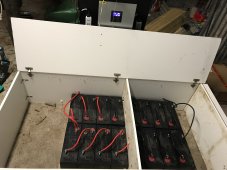Hello,
I'm very much a newbie in Australia, but I'm looking to put together my own solar power station using these types of components;
1 of these inverters;

4 of these batteries;

4 of these panels;

I was going to mount the inverter and batteries on a trolley.
This will only be to cover powering 1 fridge (150W)/ 1 freezer (125W) for 12 hours a day, 1 water pump (800W, a few times a day for maybe 20 seconds at a time), and some computer gear (300W) for 4 hours a day. I am looking to use it for a potential long term power outage (weeks/months). We already have a petrol generator attached to the house with a lot of fuel storage, so this will compliment it depending on the weather.
Is this system doable, and is it fit for purpose? How long would the batteries take to charge?
Thanks,
Mark.
I'm very much a newbie in Australia, but I'm looking to put together my own solar power station using these types of components;
1 of these inverters;

VEVOR 5KVA 48V MPPT Off-Grid Pure Sine Wave Solar Hybrid Solar Inverter Charger 824889715561 | eBay
Find many great new & used options and get the best deals for VEVOR 5KVA 48V MPPT Off-Grid Pure Sine Wave Solar Hybrid Solar Inverter Charger at the best online prices at eBay!
www.ebay.com.au
4 of these batteries;

VoltX 12V 100Ah Lithium Battery LiFePO4 Recharge Replace SLA AGM Camping Power | eBay
The 100Ah model can power all your usual devices like LED lighting, charging electronics, radios, fans, small rice cookers and kettles, and also support TVs, small fridges and power tools. Nominal Capacity: 100Ah.
www.ebay.com.au
4 of these panels;

380W Folding Solar Panel Kit 12V Mono Portable Caravan Camping Controller USB 9355348002591 | eBay
Find many great new & used options and get the best deals for 380W Folding Solar Panel Kit 12V Mono Portable Caravan Camping Controller USB at the best online prices at eBay!
www.ebay.com.au
I was going to mount the inverter and batteries on a trolley.
This will only be to cover powering 1 fridge (150W)/ 1 freezer (125W) for 12 hours a day, 1 water pump (800W, a few times a day for maybe 20 seconds at a time), and some computer gear (300W) for 4 hours a day. I am looking to use it for a potential long term power outage (weeks/months). We already have a petrol generator attached to the house with a lot of fuel storage, so this will compliment it depending on the weather.
Is this system doable, and is it fit for purpose? How long would the batteries take to charge?
Thanks,
Mark.






